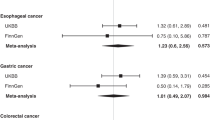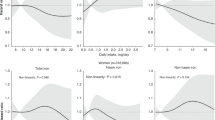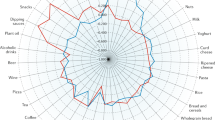Abstract
Background:
This is the largest prospective cohort analysis to assess how dietary factors involved in one-carbon metabolism are associated with endometrial cancer incidence, using 26 years of follow-up data from the Nurses’ Health Study.
Methods:
The prospective cohort analysis of one-carbon metabolism dietary factors used the Cox proportional hazards model, and incorporated 788 incident endometrial cancer events from 1980 to 2006. Genotyping and unconditional logistic regression were performed on 572 endometrial cancer cases and their matched controls to examine 29 mostly non-synonymous single-nucleotide polymorphisms involved in one-carbon metabolism.
Results:
There were no significant dose–response relationships between intake of any of the one-carbon metabolism dietary factors and endometrial cancer incidence, but alcohol consumption of <1 drink a day was significantly protective (hazard ratio: 0.80; 95% CI: 0.68, 0.94). Those with the MTHFR 677 TT or MTHFR 1298 CC genotype had more protective associations for many of the dietary factors and endometrial cancer, but statistical power was limited in this analysis.
Conclusion:
Dietary levels of folate, choline, methionine, vitamin B2, vitamin B6 or vitamin B12 do not appear to influence endometrial cancer incidence. Moderate alcohol intake may protect against developing endometrial cancer.
Similar content being viewed by others
Main
Nutrients and genetic polymorphisms in the one-carbon metabolism pathway are involved in DNA methylation and synthesis, and therefore may have an important role in carcinogenesis. There is increasing evidence that abnormal DNA methylation contributes to endometrial carcinogenesis (Muraki et al, 2009; Tao and Freudenheim, 2010), suggesting that one-carbon metabolites and enzymes may influence the development of endometrial cancer. However, previous epidemiological studies on the associations between one-carbon metabolism dietary factors and endometrial cancer have yielded inconsistent findings (Negri et al, 1996; Jain et al, 2000; Xu et al, 2007; Kabat et al, 2008; Uccella et al, 2011). In addition, these studies did not examine the influence of choline and many potentially important single-nucleotide polymorphisms (SNPs), and several of them either focus only on a few nutrients or are not prospective. Therefore, we comprehensively assess the associations between dietary and genetic factors involved in one-carbon metabolism and endometrial cancer incidence in the Nurses’ Health Study (NHS), a large cohort providing 26 years of follow-up data.
Materials and Methods
Study population
The NHS is a prospective cohort study that began in 1976, when 121 700 female registered nurses aged 30–55 and residing in 11 US states completed an initial questionnaire. From 1989 to 1990, blood was collected from 32 826 participants.
For the cohort analysis, nurses who had hysterectomy, surgical menopause or cancers other than non-melanoma skin cancer were excluded at baseline (year 1980) and each subsequent follow-up cycle. There were 1 448 170 person-years of data involving 788 cases in the cohort analysis, covering 1980 to 2006.
For the nested case–control analysis, genotyping was performed on 572 cases and 572 matched controls from the NHS cohort. Matching factors included age and menopausal status. Controls were randomly selected up to and including the questionnaire cycle in which the case was diagnosed.
Completion of the self-administered questionnaire and submission of a blood sample were considered to imply informed consent. The NHS protocol was approved by the Human Research Committee of the Brigham and Women’s Hospital, Boston, MA, USA.
Dietary exposure assessment
Intake level of one-carbon metabolism nutrients was calculated using validated food frequency questionnaire (FFQ) information as well as data from the US Department of Agriculture (U.S Department of Agriculture, 1989, 2004) and other sources (Zeisel et al, 2003). The cumulative average intake level involving information from 1980, 1984, 1986, 1990, 1994, 1998, 2002 and 2006 was used, adjusted for total energy intake.
Endometrial cancer case ascertainment
Cases of invasive type 1 endometrioid adenocarcinoma, diagnosed between 1980 and 2006, were confirmed by medical record review. There were 788 eligible incident endometrial cancer cases during this time period who did not have missing dietary data. Among those cases, 572 had blood or buccal cell samples from which DNA was extracted for genotyping.
Covariate information
Information on potential confounders was obtained from questionnaire responses that were updated every 2 years. Updated body mass index was calculated using height reported at baseline and weight reported at each cycle. Those missing weight in one cycle had their weight carried forward from the previous cycle, whereas those missing weight for two consecutive cycles were excluded until they again reported their weight. Smoking was quantified using pack-years.
SNP selection and genotyping
The SNPs were selected because they are non-synonymous ones that are likely to affect protein functionality in one-carbon metabolism (Carr et al, 2009), or have a role in choline metabolism (Zeisel, 2008). The minor allele frequencies range from 0.04 to 0.47. Genomic DNA was extracted using protocol described previously (Prescott et al, 2010). The amount of missing genotyping data was <4%.
Statistical analyses
The Cox proportional hazards model was used in the cohort analysis. The hazard ratio (HR) and 95% confidence interval (CI) were reported for risk of endometrial cancer in the categorical analysis. Tests for linear trend involved ordering the quintiles of the dietary factors and treating the values as continuous. The Anderson–Gill data structure was used to efficiently handle time-varying covariates (Therneau, 1997).
The unconditional logistic regression model was used in the nested case–control analysis involving SNPs in a Caucasian-only study sample, and the odds ratio was reported. The additive genetic model was used, which assumes that the effect of the heterozygous genotype is intermediate between the two homozygous genotypes. The homozygous genotype of the reference allele was coded as 0.
Analyses were done using the SAS Version 9.1 software (SAS Institute, Cary, NC, USA). Quintiles were created using the rank procedure. Multiplicative interaction terms involving continuous variables were created to test for effect modification using the Wald test. All P-values were two-sided.
Results
In the multivariate cohort analysis, there were no significant dose–response relationships between intake of the one-carbon metabolism dietary factors and endometrial cancer incidence (Table 1). Women with alcohol intake in the second, third or fourth quintile had a significantly lower risk of endometrial cancer compared with women with the lowest quintile of intake. However, no association was observed among women in the top category of alcohol intake. Alcohol consumption of <1 drink (14 g) a day was significantly protective (HR: 0.80; 95% CI: 0.68, 0.94).
The results of the case–control analysis involving one-carbon metabolism SNPs are shown in Tables 2 and 3. The previously well-studied MTHFR 677 and MTHFR 1298 SNPs did not significantly modify the associations between total intake of the one-carbon metabolism dietary factors and endometrial cancer incidence (Table 2). However, for the MTHFR 677 SNP, those with the TT genotype had more protective associations for folate, vitamin B2, vitamin B6, vitamin B12 and alcohol intake, with the association reaching statistical significance for vitamin B6. For those with the MTHFR 1298 CC genotype, the associations were largely more protective compared with those with the other two MTHFR 1298 genotypes. The interaction between the other one-carbon metabolism SNPs and folate intake were examined, and we found significant effect modification of the association between folate and endometrial cancer by rs2276724 (P-interaction=0.01) and rs2886059 (P-interaction=0.03). Of the SNPs in this study, only rs202676 was significantly associated with endometrial cancer (P=0.03; Table 3).
Discussion
In this large prospective study involving dietary factors in one-carbon metabolism and endometrial cancer with 26 years of follow-up, there were no significant associations between folate, choline, methionine, vitamins B2, B6, B12 and endometrial cancer incidence. Certain quantities of alcohol intake appeared to be protective against endometrial cancer. Although the MTHFR 677 and MTHFR 1298 SNPs did not significantly modify the associations between these dietary factors and endometrial cancer, the associations were suggestively more protective among those with the MTHFR 677 TT and MTHFR 1298 CC genotypes.
Our findings involving other one-carbon metabolism dietary factors are largely consistent with the results of previous studies (Negri et al, 1996; Jain et al, 2000; Xu et al, 2007; Kabat et al, 2008; Uccella et al, 2011). No previous studies have examined the association between choline and endometrial cancer, and our data suggest no association.
We found that alcohol intake below one drink a day significantly protected against endometrial cancer incidence, but there was no significant association for intake above one drink a day. This finding is remarkably consistent with the results from a recent meta-analysis involving seven cohort studies (Friberg et al, 2010). Among those consuming <1 drink a day, the meta-analysis found up to 7% decrease in endometrial cancer risk, whereas we found that the risk decreased around 20–30%.
We also examined whether genetic factors modified the associations between one-carbon metabolism dietary factors and endometrial cancer incidence. We found that despite no significant effect modification, those with the MTHFR 677 TT and MTHFR 1298 CC genotypes had more protective associations for many of the dietary factors and endometrial cancer. Another study also found a more protective association in those with the C allele for the MTHFR 1298 SNP when folate intake was high (Xu et al, 2007). For the other one-carbon metabolism SNPs examined, we found that rs2276724 and rs2886059 significantly modified the association between folate and endometrial cancer. Interestingly, both of these SNPs are on the ALDH1L1 gene. We also found that rs202676, which is on the FOLH1 gene, was significantly associated with endometrial cancer incidence. However, these findings were not statistically significant when accounting for the false discovery rate (Benjamini et al, 2001).
This is the first study involving endometrial cancer to examine the association with choline and many non-synonymous SNPs that may affect protein functionality in the one-carbon metabolism pathway. In addition, we have regularly updated information on dietary factors and many confounders, which minimises information bias and allows finer control of confounding. However, there are limitations in this analysis. First, the intake amount of the dietary factors in this cohort may not reflect that of other populations. Second, despite the detailed and regularly updated FFQ information, examining plasma biomarker levels of the one-carbon metabolism nutrients would be of interest. Finally, statistical power is limited in analyses involving the one-carbon metabolism SNPs, particularly for the interaction analyses.
Future studies involving other populations are necessary to validate our findings, especially for the lesser studied SNPs (e.g., the non-MTHFR SNPs) and nutrients (e.g., choline). It will also be informative to conduct a similar study in a population with higher intake of choline as well as plasma measurements of the nutrients.
Change history
24 January 2013
This paper was modified 12 months after initial publication to switch to Creative Commons licence terms, as noted at publication
References
Benjamini Y, Drai D, Elmer G, Kafkafi N, Golani I (2001) Controlling the false discovery rate in behavior genetics research. Behav Brain Res 125: 279–284
Carr DF, Whiteley G, Alfirevic A, Pirmohamed M FolATED study team (2009) Investigation of inter-individual variability of the one-carbon folate pathway: a bioinformatic and genetic review. Pharmacogenomics J 9: 291–305
Friberg E, Orsini N, Mantzoros CS, Wolk A (2010) Alcohol intake and endometrial cancer risk: a meta-analysis of prospective studies. Br J Cancer 103: 127–131
Jain MG, Rohan TE, Howe GR, Miller AB (2000) A cohort study of nutritional factors and endometrial cancer. Eur J Epidemiol 16: 899–905
Kabat GC, Miller AB, Jain M, Rohan TE (2008) Dietary intake of selected B vitamins in relation to risk of major cancers in women. Br J Cancer 99: 816–821
Muraki Y, Banno K, Yanokura M, Kobayashi Y, Kawaguchi M, Nomura H, Hirasawa A, Susumu N, Aoki D (2009) Epigenetic DNA hypermethylation: clinical applications in endometrial cancer (Review). Oncol Rep 22: 967–972
Negri E, La Vecchia C, Franceschi S, Levi F, Parazzini F (1996) Intake of selected micronutrients and the risk of endometrial carcinoma. Cancer 77: 917–923
Prescott J, McGrath M, Lee IM, Buring JE, De Vivo I (2010) Telomere length and genetic analyses in population-based studies of endometrial cancer risk. Cancer 116: 4275–4282
Tao MH, Freudenheim JL (2010) DNA methylation in endometrial cancer. Epigenetics 5: 491–498
Therneau TM (1997) Extending the Cox model. In: Lin DY, Fleming TR (eds) Proceedings of the First Seattle Symposium in Biostatistics: Survival Analysis. Springer: New York, NY, pp 51–84
Uccella S, Mariani A, Wang AH, Vierkant RA, Robien K, Anderson KE, Cerhan JR (2011) Dietary and supplemental intake of one-carbon nutrients and the risk of type I and type II endometrial cancer: a prospective cohort study. Ann Oncol 22: 2129–2136
U.S. Department of Agriculture (1989) Composition of Foods—Raw, Processed, and Prepared, 1963–1988 Agricultural Handbook Series, No 8. U.S. Department of Agriculture: Washington, DC
U.S. Department of Agriculture (2004) USDA USDA Database for the Choline Content of Common Foods. U.S. Department of Agriculture: Beltsville, MD
Xu WH, Shrubsole MJ, Xiang YB, Cai Q, Zhao GM, Ruan ZX, Cheng JR, Zheng W, Shu XO (2007) Dietary folate intake, MTHFR genetic polymorphisms, and the risk of endometrial cancer among Chinese women. Cancer Epidemiol Biomarkers Prev 16: 281–287
Zeisel SH, Mar MH, Howe JC, Holden JM (2003) Concentrations of choline-containing compounds and betaine in common foods. J Nutr 133: 1302–1307
Zeisel SH (2008) Genetic polymorphisms in methyl-group metabolism and epigenetics: lessons from humans and mouse models. Brain Res 1237: 5–11
Acknowledgements
We thank the NHS participants and staff for their contributions, as well as the following state cancer registries for their help: AL, AZ, AR, CA, CO, CT, DE, FL, GA, ID, IL, IN, IA, KY, LA, ME, MD, MA, MI, NE, NH, NJ, NY, NC, ND, OH, OK, OR, PA, RI, SC, TN, TX, VA, WA and WY. This research was supported by the National Institutes of Health grants P01 CA87969, R01 CA49449 and R01 CA082838.
Author information
Authors and Affiliations
Corresponding author
Rights and permissions
From twelve months after its original publication, this work is licensed under the Creative Commons Attribution-NonCommercial-Share Alike 3.0 Unported License. To view a copy of this license, visit http://creativecommons.org/licenses/by-nc-sa/3.0/
About this article
Cite this article
Liu, J., Hazra, A., Giovannucci, E. et al. One-carbon metabolism factors and endometrial cancer risk. Br J Cancer 108, 183–187 (2013). https://doi.org/10.1038/bjc.2012.534
Received:
Revised:
Accepted:
Published:
Issue Date:
DOI: https://doi.org/10.1038/bjc.2012.534
Keywords
This article is cited by
-
Urine and serum metabolomic analysis of endometrial cancer diagnosis and classification based on ultra-performance liquid chromatography mass spectrometry
Metabolomics (2024)
-
Urine metabolomics for assessing fertility-sparing treatment efficacy in endometrial cancer: a non-invasive approach using ultra-performance liquid chromatography mass spectrometry
BMC Women's Health (2023)
-
Does alcohol consumption modify the risk of endometrial cancer? A dose–response meta-analysis of prospective studies
Archives of Gynecology and Obstetrics (2017)
-
Choline and betaine consumption lowers cancer risk: a meta-analysis of epidemiologic studies
Scientific Reports (2016)



